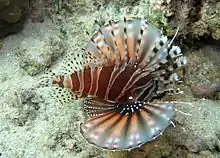Dendrochirus zebra
Dendrochirus zebra, known commonly as the zebra turkeyfish or zebra lionfish among other vernacular names, is a species of marine fish in the family Scorpaenidae.
| Dendrochirus zebra | |
|---|---|
 | |
| Scientific classification | |
| Kingdom: | Animalia |
| Phylum: | Chordata |
| Class: | Actinopterygii |
| Order: | Scorpaeniformes |
| Family: | Scorpaenidae |
| Genus: | Dendrochirus |
| Species: | D. zebra |
| Binomial name | |
| Dendrochirus zebra (G. Cuvier, 1829) | |
The zebra turkeyfish is widespread throughout the tropical waters of the Indo-West Pacific, including the Red Sea.
Description
The zebra turkeyfish is a scorpaenid fish with vertical stripes in orange, white and black on the body, and large, banded fan-like pectoral fins that flare out on either side as the fish lies on the seabed. The front dorsal fin is made up of thirteen tall, quill-like spines and the second dorsal fin has ten to eleven soft rays. The anal fin has three spines and about ten soft rays. The second dorsal fin, the anal fin and the rounded caudal fin are transversely banded in black and white. This fish grows to a maximum length of about 25 cm (10 in).[2]
Distribution and habitat
The zebra turkeyfish is native to the Indo-Pacific region from the Red Sea to Indonesia and eastern Australia. It is found in inshore waters down to a depth of about 80 m (262 ft). It is a bottom-dwelling species and is found on coral, pebble, and rock bottoms on reef flats, outer reefs and lagoons and also in caves, sometimes in small groups.[2]
Biology
This member of the scorpionfish family has thirteen venomous spines along its back, used to defend itself. These spines are connected with a clear film-like membrane. These fish are slow-moving and peaceful, but can be dangerous. They have a habit of resting in places hidden from light such as under a rock or a piece of coral.[3] All lionfish are immune to each other's venom.
Behavior
While originally described as solitary predators,[4] zebra lionfish have more recently been observed exhibiting gregarious behavior both in the wild and in a laboratory setting, living and hunting together in groups of two to three.[5]
When hunting in groups, zebra lionfish herd their prey into a confined area using their venomous dorsal spines and flaring their fins to create a barrier. Individuals were observed taking turns striking at prey, and occasionally blowing jets of water at prey.[5][6] Group hunting and water jet blowing behaviors have also been observed in invasive red lionfish in the Caribbean.[7] Signaling turns in striking and fin flaring during group hunting observed in zebra lionfish, red lionfish, and spotfin lionfish may indicate that the cooperative signaling and gregarious hunting behaviors may be characteristic of the lionfish family as a whole.[6]
The zebra lionfish feeds on small crustaceans and fish, and is in turn preyed upon by groupers.
In popular culture
The zebra lionfish has made an appearance in the Animal Crossing franchise.
References
| Wikimedia Commons has media related to Dendrochirus zebra. |
| Wikispecies has information related to Dendrochirus zebra. |
- Motomura, H. & Matsuura, K. 2016. Dendrochirus zebra . The IUCN Red List of Threatened Species 2016: e.T69793953A69800937. http://dx.doi.org/10.2305/IUCN.UK.2016-3.RLTS.T69793953A69800937.en. Downloaded on 15 December 2019.
- "Dendrochirus zebra (Cuvier, 1829): Zebra turkeyfish". FishBase. Retrieved 2013-12-19.
- Lieske, E. and R. Myers, 1994. Collins Pocket Guide. Coral reef fishes. Indo-Pacific & Caribbean including the Red Sea. Harper Collins Publishers, 400 p.
- Moyer, Jack; Zaiser, Martha (25 May 1981). "Social Organization and Spawning Behavior of the Pteroine Fish Dendrochirus Zebra". Japanese Journal of Ichthyology. 28 (1). doi:10.11369/jji1950.28.52. ISSN 1884-7374.
- Rizzari, J. R.; Lönnstedt, O. M. (6 March 2014). "Cooperative hunting and gregarious behaviour in the zebra lionfish, Dendrochirus zebra". Marine Biodiversity. 44 (4): 467–468. doi:10.1007/s12526-014-0215-6.
- Lönnstedt, Oona M.; Ferrari, Maud C. O.; Chivers, Douglas P. (June 2014). "Lionfish predators use flared fin displays to initiate cooperative hunting". Biology Letters. 10 (6): 20140281. doi:10.1098/rsbl.2014.0281. PMID 24966203.
- Albins, MA; Lyons, PJ (23 February 2012). "Invasive red lionfish Pterois volitans blow directed jets of water at prey fish". Marine Ecology Progress Series. 448: 1–5. Bibcode:2012MEPS..448....1A. doi:10.3354/meps09580. Retrieved 3 April 2020.
External links
- Dendrochirus zebra. World Register of Marine Species (WoRMS)
- Photos of Dendrochirus zebra on Sealife Collection

